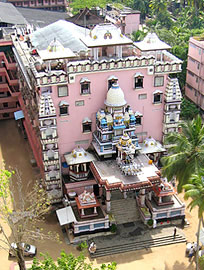The enchanting Kollam with its breathtaking scenery, with the promises of its serene water and with the significant temples stands as the logo of the word tourist satisfaction. A number of tourist places are there which has enhanced the tourist quotient.
Sri Maha Ganapathy Temple: This temple is situated in Kottarakara. The said temple is dedicated to both, Lord Ganapathy and His father Lord Siva. Praying to Lord Ganapathy on the commencement of every act or event is a common practice among Hindus. A festival lasting eleven days starting from the Kodiyattam is celebrated annually at this place.
 Matha Amrithanandamay Ashram: The Ashram of Math Amrithanandamayi situated Amrithapuri near Vallikavu is also myth the headquarters of the Matha`s Ashrams. The ashram can be reached by boat. However, there is also a road link.
Matha Amrithanandamay Ashram: The Ashram of Math Amrithanandamayi situated Amrithapuri near Vallikavu is also myth the headquarters of the Matha`s Ashrams. The ashram can be reached by boat. However, there is also a road link.
Thirumullavaram Beach: This beach in recluse as if in search of solitude. This is a placid picnic spot. The palm trees around the place add to the calm that surrounds everywhere. Frequent busses help visitors to get to the spot from the town.
Picnic Village: Recreation is at a high in the Picnic Village located at Ashramam in Kollam. The back water here is typical of the Kerala backwaters. A Government guest house built two centuries ago which is a real help to the tourists. A tourist boat club, an adventure park, a traffic park for children imparting the important knowledge of traffic rules and their importance in the young all-grasping minds and a `Yathri Nivas` are among some of the salient features.
Kottukkal Rock Cut Cave Temple: This temple is separated from Chadayamangalam. Th separation is by a mere 1 km on the M.C. Road between Thiruvananthapuram and Kottayam. This temple is an excellent specimen of rock cut architecture. Hundreds of visitors, come, stand and admire the place as well.
Jatayu Para: This is a huge rock at Chadayamangalam on which, as the legend says, the Mythical Eagle `Jatayu` breathed His last after His bid to avert the demon King Ravana abducting Sita, went in vain. `Jatayu` as was called the mythical Eagle and `Para`, meaning rock constitute name of the gigantic rock of logical importance.



















